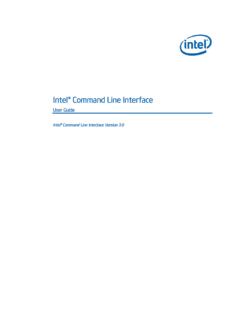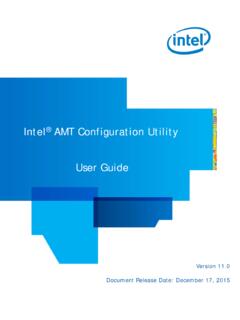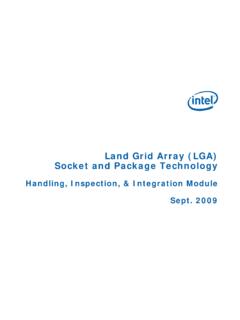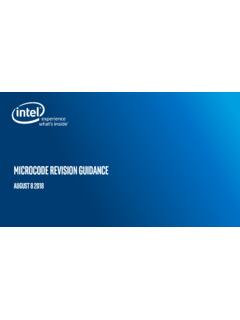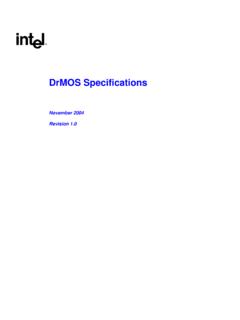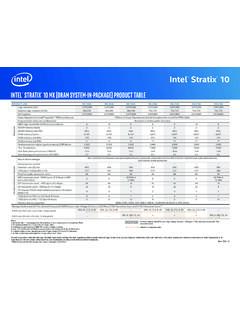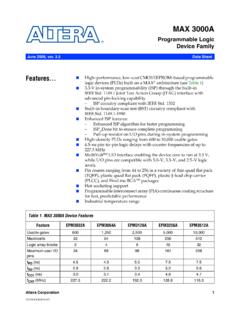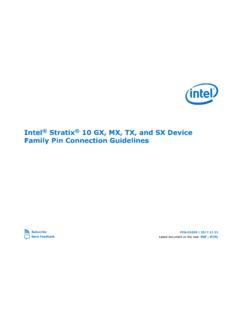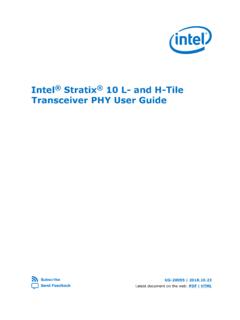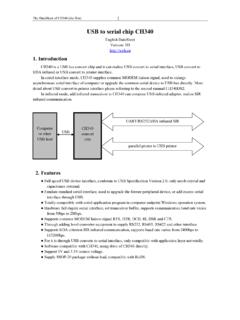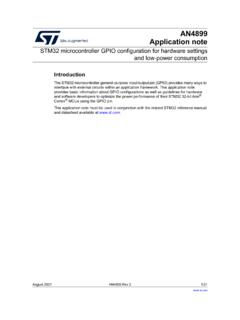Transcription of Intel® Chipsets Low Pin Count Interface Specification
1 intel low pin Count (LPC) Interface SpecificationAugust 2002 Revision Number: 251289-001 RIntroductionR2251289-001 Information in this document is provided in connection with intel products .No license, express or implied, by estoppel or otherwise, to anyintellectual property rights is granted by this document .Except as provided in intel s Terms and Conditions of Sale for such products, intel assumesno liability whatsoever, and intel disclaims any express or implied warranty, relating to sale and/or use of intel products including liability orwarranties relating to fitness for a particular purpose, merchantability, or infringement of any patent, copyright or other intellectual products are not intended for use in medical, life saving, or life sustaining may make changes to specifications and product descriptions at any time, without must not rely on the absence or characteristics of any features or instructions marked "reserved" or "undefined.
2 " intel reserves these forfuture definition and shall have no responsibility whatsoever for conflicts or incompatibilities arising from future changes to Specification IS PROVIDED "AS IS" WITH NO WARRANTIES WHATSOEVER, INCLUDING ANY WARRANTY OF MERCHANTABILITY,NON-INFRINGEMENT, FITNESS FOR ANY PARTICULAR PURPOSE, OR ANY WARRANTY OTHERWISE ARISING OUT OF ANY PROPOSAL, Specification OR SAMPLE . intel disclaims all liability, including liability for infringement of any proprietary rights, relating to use of information inthis Specification .No license, express or implied, by estoppel or otherwise, to any intellectual property rights is granted herein, except that a licenseis hereby granted to copy and reproduce this Specification for internal use may have patents and/or patent applications related to the various low pin Count interfaces described in the low pin Count (LPC) InterfaceSpecification, Revision A reciprocal, royalty-free license to the electrical interfaces and bus protocols described in, and required by, the LowPin Count (LPC) Interface Specification , Revision is available from your local intel sales office or your distributor to obtain the latest specifications and before placing your product of documents which have an ordering number and are referenced in this document, or other intel literature, may be obtained from.
3 intel call 1-800-548-4725 intel and the intel logo are trademarks or registered trademarks of intel Corporation or its subsidiaries in the United States and other countries.*Other names and brands may be claimed as the property of 2002, intel of the LPC Interface (I/F) .. and Functionality Requirements .. 82 Signal 93 Block Diagram .. 114 Protocol Overview .. Types .. , I/O, and DMA Cycle Overview .. [3:0].. Type / Direction (CYCTYPE + DIR) .. (TAR).. Time-out .. Error Indication .. # .. of Cycle .. Mechanism .. Memory Cycle Overview .. Definitions .. (Device Select).. (Memory Address) .. (Memory Size) .. Memory Read Cycle .. Memory Write Cycles .. Reporting .. 245 Target Protocol .. Cycles .. Cycles .. Memory Cycles .. 296 Direct Memory Access (DMA) Protocol .. DMA Requests .. DMA Transfers .. Count .. Mode .. Request field / LDRQ# Rules.
4 Notes on 16 and 32 Bit 377 Bus Master Protocol .. Formats and Timing .. Assertion 438 Power Management .. # Protocol .. # Protocol .. # Voltages .. 469 Reset 4710 Electrical [3:0] / LFRAME# / LDRQ# / SERIRQ / LPME# .. # / LSMI#.. # / LCLK / CLKRUN# .. Pull-Up Requirements .. 5011 Host / Peripheral and Decode Ranges .. Master START 5212 Bandwidth Calculations .. Performance Requirements .. 54 IntroductionR251289-0015 FiguresFigure 1: Typical 11 Figure 2: Typical Timing for LFRAME#.. 19 Figure 3: Extended Timing for LFRAME#.. 19 Figure 4: Abort Mechanism .. 20 Figure 5: Firmware Memory Cycle Preamble .. 23 Figure 6: Firmware Memory Cycle Single Byte Read .. 23 Figure 7: Firmware Memory Cycle Single Byte Write .. 24 Figure 8: DMA Request Assertion through LDRQ# .. 32 Figure 9: Timing for Entering and Exiting the Power Down 46 TablesTable 1: LPC Required Signal List.
5 9 Table 2: LPC Optional Signal 9 Table 3: Cycle Types .. 13 Table 4: Firmware Memory Size Field .. 22 Table 5: Target Memory Cycle Field Definitions .. 25 Table 6:Host Initiated Memory Read .. 26 Table 7: Host Initiated Memory Write .. 26 Table 8: Target I/O Cycle Field Definitions .. 27 Table 9: Host Initiated I/O Read 27 Table 10: Host Initiated I/O Write 28 Table 11: Target Firmware Memory Cycle Field Definitions .. 29 Table 12: Host Initiated Firmware Memory Read .. 30 Table 13: Host Initiated Firmware Memory Write .. 30 Table 14: DMA Field Definitions .. 33 Table 15: DMA Read Cycle (Host to Peripheral) .. 36 Table 16: DMA Write Cycle (Peripheral to Host) .. 37 Table 17: Bus Master Cycle Field Definitions .. 39 Table 18: Peripheral Initiated Memory Read Cycle .. 41 Table 19: Peripheral Initiated Memory Write Cycle .. 41 Table 20: Peripheral Initiated I/O Read Cycle .. 42 Table 21: Peripheral Initiated I/O Write Cycle.
6 42 Table 22: LPCPD# Electrical 49 Table 23: LSMI# Electrical Characteristics .. 50 Table 24: Recommended Pull-Up Values .. 50 Table 25: Legacy Host Decode Ranges .. 51 Table 26: IO Performance .. 54 IntroductionR6251289-001 Revision HistoryRev. Date- Revision - Initial release. No Document Number Assigned- 001 Revision - Assigned Document Number 251289 - 001 Added Sections and describing Firmware Memory Cyclesincluding support for multi-byte read and write accesses. Added electrical characteristics for LPCPD# and LSMI# signals inSection Clarified electrical requirements for LRESET#,LCLK, and CLKRUN# in Section Added recommended pull-up resistor requirements in Added additional description to system reset requirements inSection 9. Made clarifications and document contains a Specification for a new low pin Count bus Interface , called LPC. Thetarget audiences for this document are system and component of the LPC Interface (I/F) Enable a system without an ISA or X-bus.
7 Reduce the cost of traditional X-bus devices. Intended for use by devices down on a motherboard only ( no connector). Meet the data transfer rate of X-bus, and exceed those data rates where appropriate. Perform the same cycle types as the X-bus: Memory, I/O, DMA, and Bus Master Support new Firmware Memory cycle type allowing separate boot BIOS firmware memorycycles and application memory cycles. Increase the memory space from 16MB on the X-bus to 4GB to allow BIOS sizes much greaterthan 1MB, and other memory devices outside of the traditional 16MB range. Synchronous design. Much of the challenge of an X-bus design is meeting the different, andin some cases conflicting, ISA timings. Make the timings synchronous to a reference wellknown to component designers, such as PCI. Software transparency: do not require special drivers or configuration for this Interface . Themotherboard BIOS should be able to configure all devices at boot.
8 Support desktop and mobile implementations. Ability to support a variable number of wait-states. Ability to have I/O and memory cycles retried in SMM handler. Ability to support wake-up and other power state and Functionality Requirements Only the following class of devices may be connected to the LPC Interface : Super I/O (FDC, SP, PP, IR, KBC) => I/O slave, DMA, Bus Master (for IR, PP) Audio, including AC'97 style design => I/O slave, DMA, Bus Master Generic Application Memory, including BIOS => Memory Slave BIOS Firmware Memory => Firmware Memory Slave Embedded Controller => I/O slave, Bus Master Interrupts are communicated with the serial interrupt (SERIRQ) protocol. The LPC Interface does not need to support high-speed buses (such as Cardbus, 1394, etc)downstream, nor does it need to support low-latency buses such as portion of the Interface that is connected either directly to the CPU or toupstream devices connected to the CPU.
9 This is typically a system chip-set .PeripheralDevices downstream on LPC that were previously connected to the X-bus, suchas Super I/O components, flash, and other embedded controllers. XXXXb Indicates the value of a signal in binary DefinitionR251289-00192 Signal DefinitionTable 1 and Table 2 lists the 7 required and 6 optional signals used for the LPC Interface . Many ofthe signals are the same as signals found on the PCI Interface , and do not require any new pins onthe host. Both hosts and peripherals must implement required signals. Optional signals may ormay not be present on particular hosts or 1: LPC Required Signal ListSignalPeripheralHostDescriptionLAD[3 :0]I/OI/OMultiplexed Command, Address, and Data:SeeSection for details on the usage of these #IOFrame:Indicates start of a new cycle, termination ofbroken #IIReset:Same as PCI Reset on the host .The host doesnot need this signal if it already has PCIRST# on :Same 33 MHz clock as PCI clock on the clock phase with typical PCI skew.
10 The host doesnot need this signal if it already has PCICLK on 2: LPC Optional Signal ListSignalPeripheralHostDescriptionLDRQ# OIEncoded DMA/Bus Master Request:Only needed byperipherals that need DMA or bus mastering .Requires anindividual signal per peripheral .Peripherals may not sharean LDRQ# IRQ:Only needed by peripherals that needinterrupt support .This signal is required for the host if itdoes not contain the ISA IRQ lines as #ODI/ODClock Run:Same as PCI CLKRUN# .Only needed byperipherals that need DMA or bus mastering in a systemthat can stop the PCI bus (generally in mobile systems).This signal is optional for the #ODI/ODLPC Power Management Event:Similar to PCI PME#.Used by peripherals to request wake-up from a DefinitionR10251289-001 SignalPeripheralHostDescriptionLPCPD#IOP ower Down:Indicates that the peripheral shouldprepare for power to be removed from the LPC I/Fdevices.
